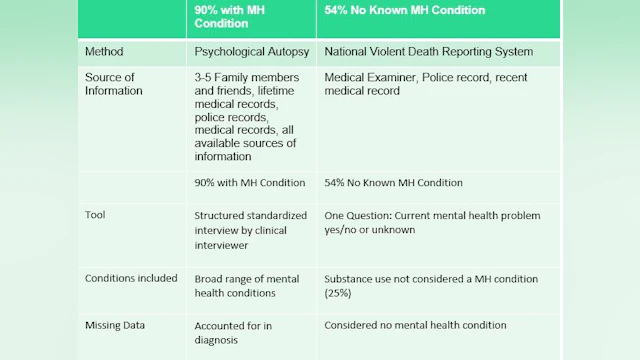Dear Dr. Jill,
I’m confused about the statistics I’ve read about mental health and suicide. Does mental illness play a role or not?
Sincerely,
Sara A.
Dear Sara A.,
If you are confused by the numbers describing how many people who die by suicide have a mental health condition, you are not alone. For years, the American Foundation for Suicide Prevention and other organizations have been stating that 90% of people who die by suicide have a diagnosable and potentially treatable mental health condition, even if they don’t realize it or are not obtaining treatment. Yet last year, the Center for Disease Control CDC (see chart below) said that 54% of people who die by suicide had no known mental health conditions. How can this be?
It’s a matter of approach, and how the studies were conducted. The finding that 90% of people who die by suicide have a mental health condition has been found by about 30 studies from around the world, across many age groups. The information that went into these studies is gathered using a method known as a psychological autopsy.
What is a psychological autopsy? It’s a method that gathers a large, detailed amount of information systematically from family members and friends, as well as other sources of information about the person who died by suicide or other causes of death. The same standardized interview is used for all individuals who participate in a psychological autopsy. All the information is synthesized to develop a picture of a person and their life during the months, and sometimes years, before they died.
The CDC finding, that 54% of people who die by suicide have no known mental health condition, comes from the National Violent Death Reporting System (NVDRS), which is an essential accounting of suicides and violent deaths. The data are gathered from coroners and medical examiners, police, and medical records, when available. Based on the data, a form is completed by a state staff person who fills out a standardized form and provides a written narrative. AFSP has vigorously advocated for full funding of the NVDRS across all fifty states, because we need more information about those who die by suicide, in order to help us learn how to prevent suicide.
The data reported in the CDC study was based on the NVDRS check box “current mental health conditions: Yes/No/Unknown.” Individuals with known substance use disorders (approximately 25% of people) were coded as “No.” This is an important point, because substance use disorder is considered a mental health condition, and is often accompanied by other mental health conditions. It’s also important to note that missing data, which was considerable, was coded as “unknown.”
The 54% number was arrived at by summing up the “No’s,” “Unknowns,” and missing data. So it doesn’t mean these people didn’t have a mental disorder: it just means that the police, coroner and medical records didn’t record any mental disorder in the form. It’s also not known if anyone was ever asked about the presence of a mental disorder when the information was recorded. Keep in mind that reports are completed at the time of death or close to it, which is a very difficult time for family. Some families may not, in this immediate moment after the death, have fully processed the cause being suicide, or may not know or want to admit that their loved one had a mental illness. There is also no systematic assessment conducted to get the NVDRS data, so it’s not surprising, given these factors, that there is no known mental disorder recorded for just more than half of people.
So, you can see how the research on mental health and suicide based on psychological autopsy studies and the CDC’s NVDRS can differ. Though not exactly the same across all studies and in all countries, the findings across psychological autopsy studies are pretty close. It is likely that most people who die by suicide are in terrible emotional pain. Psychological autopsy study results are that approximately 90% percent of people who died by suicide had a diagnosable and potentially treatable mental health condition at the time of their death. [CDC Vital Signs, June 2018]
It’s important to note, however, that most people with mental health conditions do not die by suicide. We don’t know as much about the mental health of those who have thought about suicide, or made a suicide attempt and survived. Research findings are that about one third of those who die by suicide are thought to be in mental health treatment at the time of their death. This suggests that we need to do a better job of facilitating access to effective mental health care, and decreasing negative views of those with mental health conditions. Improving mental health is only one of the many factors that contribute to preventing suicide, and it is an important component.

Would you like to share or read this story offline? Download a shareable copy.
